Report
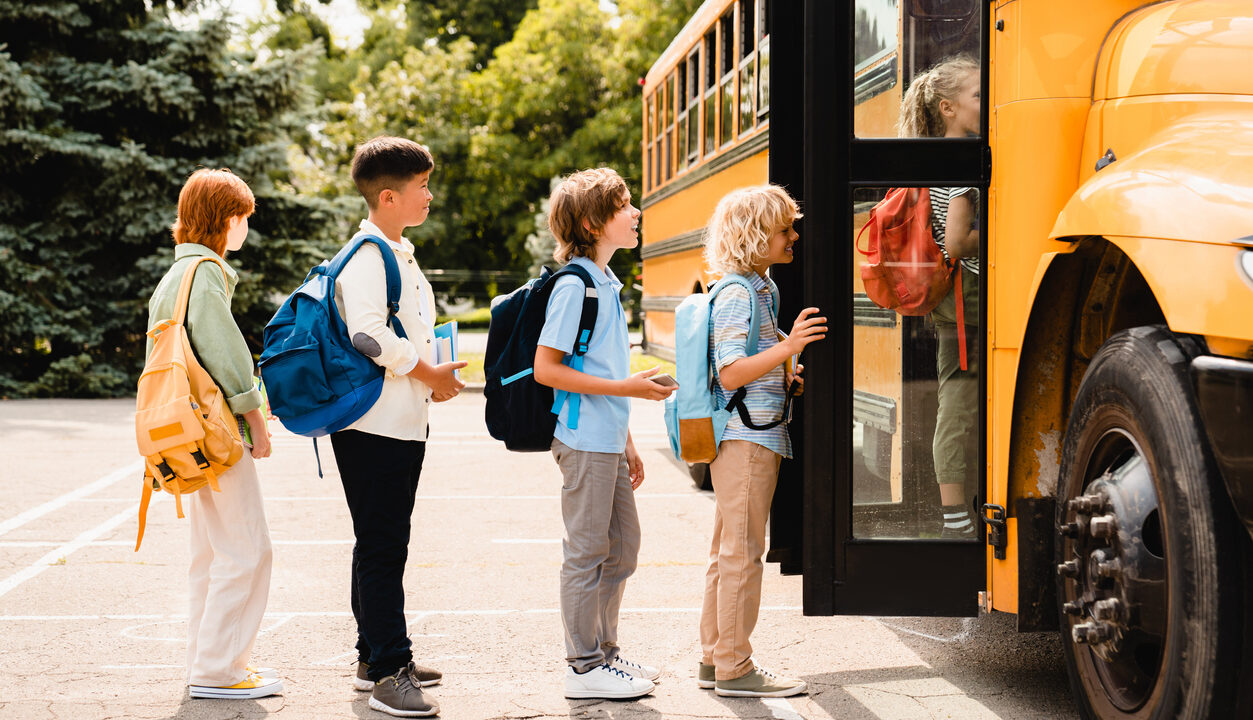
Pa. Back to School Education Trends
Overview
As students head back to school, there are many claims of teacher shortages and funding shortfalls. In reality, public school spending is at a record high and Pennsylvania ranks among the highest spending states in the county. The latest state budget increased funding for public schools by a massive $1.5 billion total, on top of these already record-high levels.
Meanwhile, enrollment in public schools has dropped, but the number of teachers and other school employees has increased. While certain local districts face teacher shortages, this has been exacerbated by shrinking districts hiring and retaining staff. This disparity could be resolved if funding followed the child.
Further, pension reform could alleviate the struggles in hiring teachers. While the average Pennsylvania teacher earns more than $70,000, school districts spend more than $20,000 per teacher to pay off pension liabilities. That is, had Pennsylvania converted to a defined contribution retirement system, public schools could provide $90,000 in average teacher salaries at current spending levels.
Key Points
- Since 2000, Pennsylvania public school enrollment has dropped 6.6 percent (120,000 fewer students); but public schools have added 20,000 more employees (8.7 percent growth), including nearly 40 percent growth among administrators.
- The average Pennsylvania public school teacher earns $71,000 in salary, the 11th highest in the nation. Meanwhile, school districts spend, on average, $20,000 per teacher in pension contributions to pay off unfunded liabilities.
- Pennsylvania school districts spent $19,900 per student in 2020–21, ranking 8th in the nation at more than $4,000 more than the national average.
- State support of public education is up 47 percent over the last decade, reaching an all-time high of $14.7 billion in 2022-23.
- Pennsylvania school districts are stockpiling taxpayer resources, with over $5.29 billion in general reserve funds and another $4.72 billion (includes charter schools and other public schools) in unspent federal pandemic aid still sitting in the treasury.
PreK-12 School Enrollment is Declining
Pennsylvania public schools have experienced overall reductions in student enrollment. Meanwhile, the number of parents choosing to homeschool their children has dramatically increased, fueled in large part by the COVID-19 pandemic.
- Pennsylvania public schools lost more than 120,000 students, or 6.6 percent from1999-2000 to 2021-22.[1]
- District schools lost more than 289,000 students, or 16.1 percent; while charter schools grew by 152,000.
- Nearly 60,000 students are enrolled in Career and Technical Schools or Intermediate Unit Programs.
- Private school enrollment also dropped during this time frame, with 82,000 fewer students enrolled in private and nonpublic schools, a 28.1 percent decline.[2]
- Homeschooling rose by 75.5 percent from 1999-2000 to 2020-21—with a major increase in 2020-21 during the COVID-19 pandemic.[3]
- The largest dip in school district enrollment occurred after 2019–20, following the start of the COVID-19 pandemic, with almost 51,000 students leaving school districts.[4]
- In Philadelphia alone, more than 9,000 students, or 7.5 percent, have left the school district since the start of the pandemic.[5]
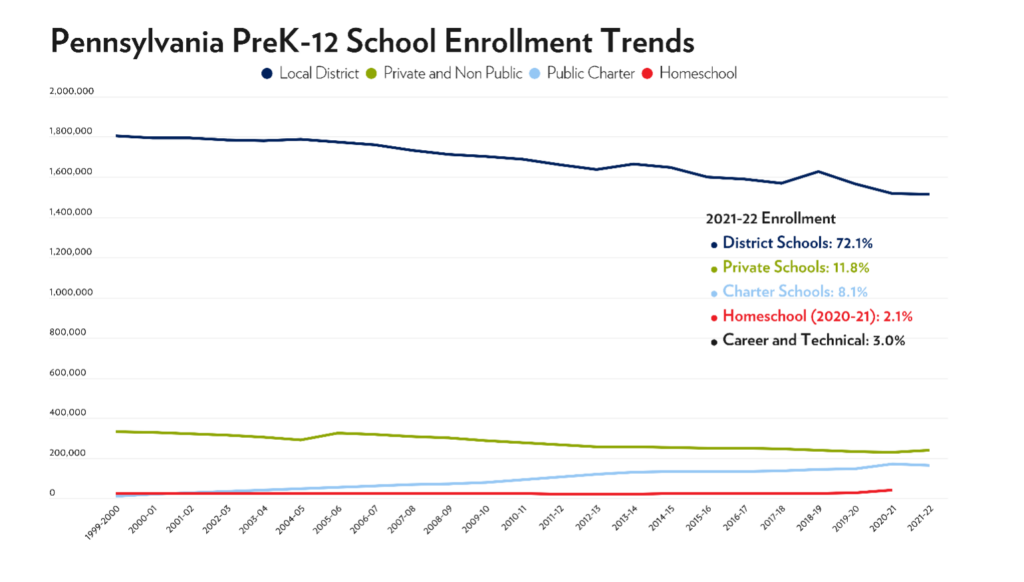
Public School Employment is Growing
Although student enrollment has declined across Pennsylvania, public school employment of teachers and administrators has increased. Individual school districts largely retain funding despite declines or increases in student enrollment.
- From 1999-2000 to 2020-21, even as enrollment declined, Pennsylvania public schools added 20,109 employees, a growth rate of 8.7 percent.[6]
- Public schools added more than 6,500 classroom teachers (5.7 percent growth) and 4,760 support staff (5.1 percent)
- The largest growth was in all other categories of “professional staff”—including administrators, coordinators, and “other professional staff.” Public schools added 8,750 non-teacher professional staff, a growth rate of 38.5 percent
- At the same time, the student-to-teacher ratio in public schools dropped from 15.7 to 1 to 14.3 to 1.
- This student-to-teacher ratio varies by school district, from 18.7 to 1 at Greater Nanticoke Area in Luzerne County down to 4.6 to 1 at Harmony Area in Clearfield County.
- The ratio of students to total employment dropped from 7.8 to 1 to 6.9 to 1.
- Some school districts are experiencing teacher shortages and difficulty hiring teachers. Focusing funding on school districts instead of students exacerbates teacher hiring problem.
- Statewide, there are more teachers (as well as more administrators and more support staff) but fewer students.
- Even school districts with shrinking enrollment have added teachers and other staff or retained more than their enrollment required.
- This over-hiring had led to shortages in school districts that face greater challenges in teacher hiring.
- This hiring problem is because funding doesn’t follow students. School districts with shrinking enrollment have continued to get funding increases (due to “hold harmless” provisions).
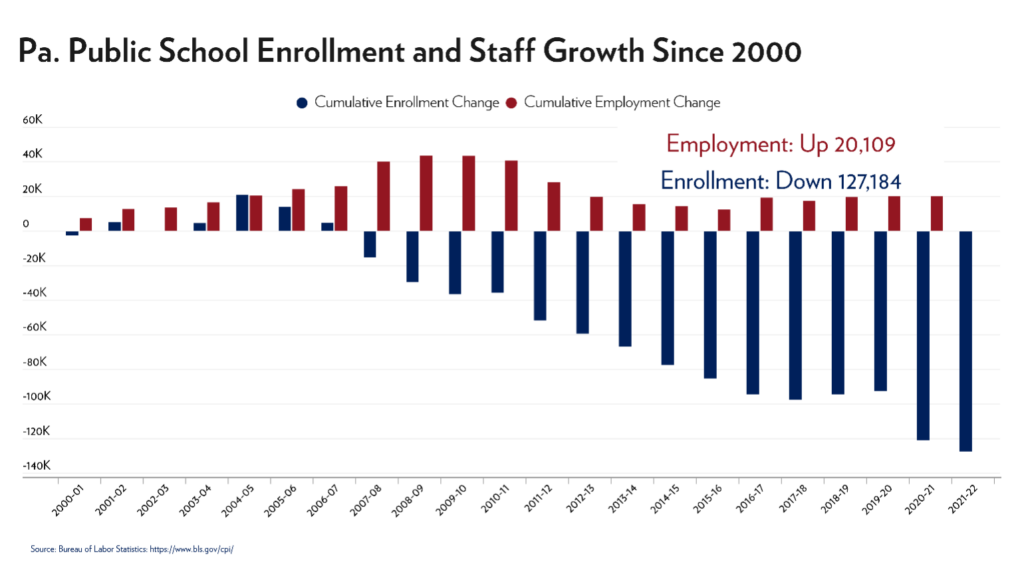
Past Pension Liabilities Limit Teacher Pay
Pennsylvania teachers are, on average, among the highest paid teachers nationally. Employee benefit costs have skyrocketed because of past policy decisions—supported by the school unions—to underfund the school pension system and push off needed pension reform.
- The average salary for a classroom teacher in Pennsylvania public schools was $71,479 as of 2020-21, according to the Pennsylvania Department of Education.[7]
- This ranks Pennsylvania 11th highest in average teacher pay, according to the NEA.[8]
- While teacher pay is relatively high compared to the national average, the cost of employee benefits has skyrocketed, crowding out salary increases.
- In 2020-21, Pennsylvania public schools spent $8.7 billion on employee benefits. This comes to nearly $35,000 per employee.[9]
- From 2011-12 to 2020-21, total public school spending on salaries increased 15 percent; meanwhile spending on employee benefits increased 82 percent, as retirement contributions (i.e., pension payments) increased 342 percent.[10]
- For school year 2022-23, the pension contribution rate for all Pennsylvania public schools will be 35.26 percent;[11] all public districts must contribute 35 percent of salaries (in aggregate) towards that state-run pension plan for school employees (PSERS).
- The lion’s share of this contribution rate—28.24 percent—isn’t to increase employee benefits, but to pay off past unfunded pension liabilities (or debt).
- That rate (28.24 percent) equals $20,186 when imposed on the average teacher salary.
- If Pennsylvania had enrolled all employees in a defined contribution plan, like a 401k, there would be no pension debt to pay off. Had lawmakers done so, Pennsylvania public schools could be paying teachers an additional $20,000 per year, without increasing overall spending.
Pennsylvania Public School Spending is Growing
Over the last decade, taxpayer spending on Pennsylvania public schools has consistently increased, reaching all-time highs year after year.
- Pennsylvania per-pupil public school funding increased to $19,919 in 2020–21, up 33.9 percent since 2013, according to data from the Pennsylvania Department of Education (PDE).[12]
- This spending increase occurred before Pennsylvania distributed most of its federal pandemic aid and increased public school funding in the last two state budgets.
- Total school district spending from all sources (local, state, and federal) increased to $33.67 billion in 2020–21, up 32 percent since 2013.
- The Pennsylvania state budget increased state support of public schools to $14.7 billion, with a $650 million increase in 2021–22 and a $1.5 billion increase in 2022-23.[13]
- State support of public schools has increased 46.9 percent since 2014 (since Gov. Wolf took office) with a total increase of $4.7 billion.
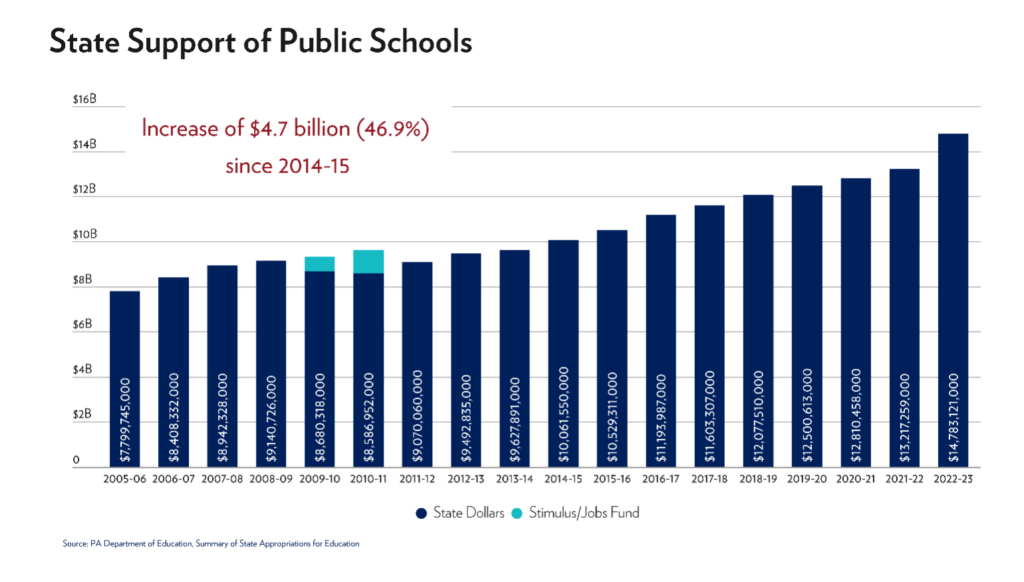
Pennsylvania Outspends the Nation on Public Schools
Pennsylvania ranks among the highest spending states on public education.
- At nearly $20,000 per student, Pennsylvania spends almost $4,000 more than the national average. The commonwealth’s spending per student exceeds the national average for every funding source—federal, state, and local.[14]
- As of fiscal year 2020 (the most recent data available), Pennsylvania ranks 8th in total per-student funding, 7th in local per-student funding, and 25th in state per-student funding.
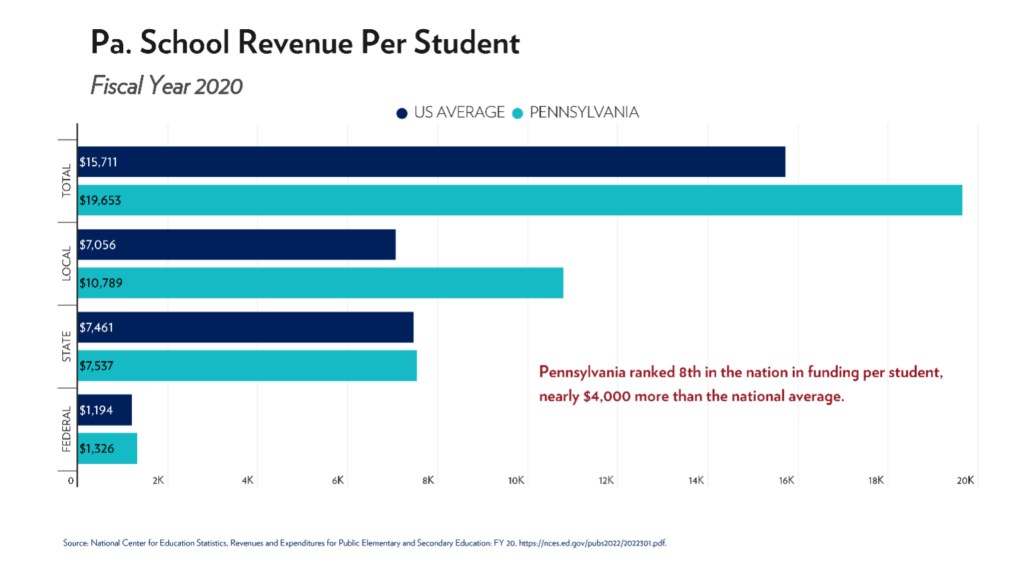
School Districts are Stockpiling Reserve Funds
While some rainy-day funds are important for weathering unforeseen events, school districts have amassed excessive stockpiles of taxpayer resources.
- Pennsylvania Department of Education data reveals that public school districts collectively stockpiled $5.29 billion in reserve funds in 2020-21, up 32.7 percent since 2013.[15]
- School district reserves consist of assigned, unassigned, and committed funds. While the intent for assigned funds may be for capital improvements, reserve funds are fungible, which allows school districts to repurpose their use.
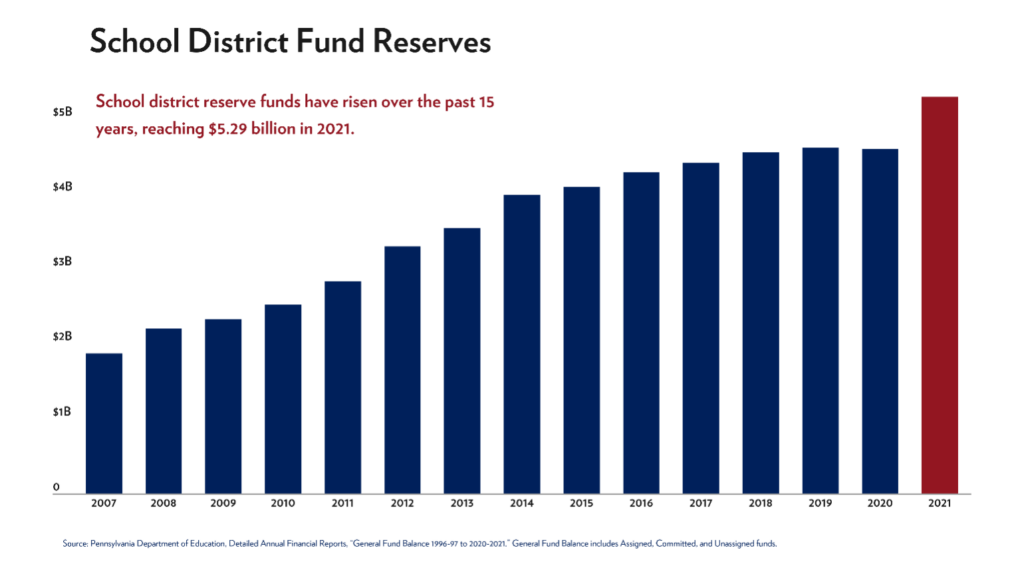
Public Schools Still Haven’t Spent Federal Money for “Reopening”
Calls for increases in state education funding come even aspublic schools sit on billions of unspent federal aid. This leftover federal money is in addition to the billions school districts hold in general reserves.
- Since 2019, Pennsylvania public schools were granted more than $6.7 billion in federal pandemic aid through three packages: Federal Coronavirus Aid, Relief, and Economic Security (CARES) Act, Coronavirus Response and Relief Supplemental Appropriations Act (CRRSA), and American Rescue Plan (ARP).
- As of mid-August 2022, Pennsylvania public schools (including district and charter schools) still have $4.72 billion in unspent federal pandemic aid.[16]
Summary
Pennsylvania spends nearly $20,000 per student in public schools, with state and local taxpayer funding constantly increasing. School districts have fewer students, but more teachers, more administrators, more support staff, and significantly larger reserve funds.
The issue isn’t a lack of money, but how it is distributed. State lawmakers should work to ensure that funding follows the child, not the building, and continue progress on pension reform that benefits both teachers and taxpayers.
[1] Pennsylvania Department of Education, Public School Enrollment Reports, https://www.education.pa.gov/DataAndReporting/Enrollment/Pages/PublicSchEnrReports.aspx
[2] Pennsylvania Department of Education, Private and Nonpublic School Enrollment Reports, https://www.education.pa.gov/DataAndReporting/Enrollment/Pages/PrivateNPEnrRpts.aspx
[3] Pennsylvania Department of Education, Home School Education, https://www.education.pa.gov/DataAndReporting/HomeSchool/Pages/default.aspx
[4] Pennsylvania Department of Education, Enrollment Reports, https://www.education.pa.gov/DataAndReporting/Enrollment/Pages/default.aspx.
[5] https://www.philasd.org/performance/programsservices/open-data/school-information/#district_enrollment
[6] Pennsylvania Department of Education, Professional Staff Summary, https://www.education.pa.gov/DataAndReporting/ProfSupPers/Pages/ProfStaffSummary.aspx; Pennsylvania Department of Education, Support Staff Summary, https://www.education.pa.gov/DataAndReporting/ProfSupPers/Pages/SupportStaffSum.aspx
[7] Pennsylvania Department of Education, Professional Staff Summary, https://www.education.pa.gov/DataAndReporting/ProfSupPers/Pages/ProfStaffSummary.aspx
[8] National Education Association, Rankings and Estimate, https://www.nea.org/sites/default/files/2022-04/2022 percent20Rankings percent20and percent20Estimates percent20Report.pdf
[9] Pennsylvania Department of Education, Summaries of Annual Financial Reports: Detailed, https://www.education.pa.gov/Teachers percent20- percent20Administrators/School percent20Finances/Finances/AFR percent20Data percent20Summary/Pages/AFR-Data-Detailed-.aspx
[10] Ibid.
[11] Pa. Public School Employees Retirement System, Employer Contribution Rates, https://www.psers.pa.gov/FPP/Publications/General/Pages/Employer-Contribution-Rates.aspx
[12] Pennsylvania Department of Education, AFR Data Files, 2020–21, https://www.education.pa.gov/Teachers percent20- percent20Administrators/School percent20Finances/Finances/AFR percent20Data percent20Summary/Pages/default.aspx.
[13] Pennsylvania Department of Education, Summary of State Appropriations for Education, 2022–23, https://www.education.pa.gov/Teachers percent20- percent20Administrators/School percent20Finances/Education percent20Budget/Pages/default.aspx.
[14] National Center for Education Statistics, “Revenues and Expenditures for Public Elementary and Secondary Education: FY 20”, May 2022, https://nces.ed.gov/pubs2022/2022301.pdf.
[15] Pennsylvania Department of Education, AFR Data Detailed, General Fund Balance 2020-21, https://www.education.pa.gov/Teachers percent20- percent20Administrators/School percent20Finances/Finances/AFR percent20Data percent20Summary/Pages/AFR-Data-Detailed-.aspx.
[16] Pa. Treasury Accounting Bureau, Status of Appropriation, Year to Date through Accounting Period 11 and Fiscal Year 2021, “COVID-ESSER-LEA”, May 2022 report, https://www.patreasury.gov/tabs/.